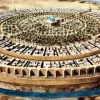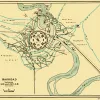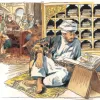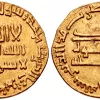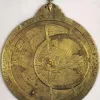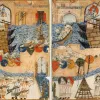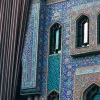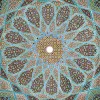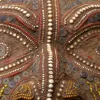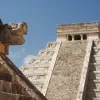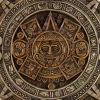Baghdad c900
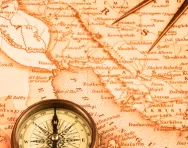
Why was Baghdad important?
The Abbasid Caliphate established their capital in the city of Baghdad in 762CE.
Over the next five centuries Islamic culture flourished and Baghdad became renowned as a centre of learning and tolerance.
Scholarship was encouraged and scientists, doctors, philosophers and engineers made significant advances in their fields. Art and architecture combined to produce beautiful mosques and palaces.
This period is known as the Golden Age of Islam.
Top 10 facts
- In 762 CE the Abbasid Caliphate, under the Caliph al-Mansur, moved the capital of the Muslim world to the newly founded city of Baghdad.
- The city, known as ‘the Round City’, was built as two large semicircles with a mosque at the centre and housed the caliph’s palace, libraries, government and military buildings. It also contained parks, gardens, squares and wide avenues.
- Residential areas for all but the most important people, markets and businesses were built outside the city walls.
- Until its destruction by the Mongols in 1258, Baghdad was a world centre of culture and learning. This period is sometimes known as the Golden Age of Islam.
- It is estimated that during the period c900-1200 the population of Baghdad reached between 1,200,000 and 2,000,000 people.
- The House of Wisdom housed a library and attracted scholars from around the world who translated texts from the classical world into Arabic. Much ancient knowledge was preserved and the development of Islamic theology, philosophy, science and medicine was stimulated.
- Islamic scholars and inventors adopted the Hindi symbol for zero and style of numerals (1, 2, 3, 4, 5, etc.) which we still use today. This enabled them to explore and develop new areas of mathematics such as algebra, algorithms and the tessellation of shapes.
- Besides the Shi’ite and Sunni Muslims who lived in the city, Baghdad was home to many different religious and ethnic communities. These included Christians, Jews, Gnostics and Zoroastrians who regulated their own communal affairs and lived in different areas of the city. Many elements of Persian and Egyptian culture were also adopted.
- Baghdad was situated on the banks of the Tigris. The city’s docks accommodated hundreds of different boats including trading vessels, pleasure crafts and warships. Merchants and sailors brought precious goods, news and knowledge from around the world into the city.
- Islamic (Sharia) law and Arabic grammar were standardised during this time. The use of a common Arabic language helped to unify the people of the Empire and meant that knowledge could be spread more widely.
Baghdad Timeline
- 750 CEAbbasid dynasty become rulers of Muslim Empire
- 751CEArabs learn to make paper from Chinese prisoners of war
- 762 CECaliph Al-Mansur founds city of Baghdad
- 764-768 CEConstruction of city of Baghdad
- 786-809 CEFifth Abbasid Caliph, Harum al-Rashid, establishes the House of Wisdom and the Baghdad hospital
- 830 CEAl-Khwarizmi writes his book on algebra
- 950 CEDeath of the philosopher Al-Farabi, who spent most of his life in Baghdad
- 1021 CEIbn al-Haytham publishes his Book of Optics
- 1037 CEDeath of Avicenna, philosopher and physician who made important discoveries regarding the transmission of disease
- 1055 CEBaghdad captured by Seljuk Turks
- 1065 CEFoundation of Al-Nizamiyya university in Baghdad
- 1096 CECrusades begin
- 1258 CEMongols sack Baghdad


Boost Your Child's Maths & English Skills!
- Get a tailored learning plan for your child
- Complete the activities added each week
- See your child jump ahead in their knowledge and confidence
Did you know?
- Baghdad may have been the first city to have over a million inhabitants.
- The city took only four years to build, a project that involved over 100,000 workers.
- By the 8th century Islamic scholars were using paper rather than parchment or papyrus for their writing. This meant they could produce texts more rapidly and on a greater scale than had previously been possible. Paper did not arrive in Europe until the 10th century.
- Scholars from as far afield as India and China were employed at the House of Wisdom. A scholar enjoyed considerable status and the most highly regarded were very well paid.
- When the Mongols destroyed the city they threw so many manuscripts into the Tigris that its waters were said to have run black with ink.
- The stories of One Thousand and One Nights were gathered together and published during this period.
Look through the gallery below and see if you can spot the following images:
- An artist's impression of Baghdad
- A plan of Baghdad showing the Tigris river
- A scholar at the library
- Coins from the Abbasid caliphate
- The earliest dated astrolabe
- The Mongol army lay siege to Baghdad
- Islamic architecture and art
Gallery
About
The Middle East was a natural crossroads for travellers and traders from Europe, Asia and Africa. Baghdad, located at the point where the Tigris flows closest to the Euphrates, was ideally placed for global trade. It swiftly became an important centre for the collection and dispersal of knowledge and ideas from around the known world. The spread of agricultural knowledge and techniques and the introduction of new crops and food stuffs may have, in turn, encouraged population growth.
The Abbasids encouraged the gathering of texts and welcomed scholars from many different cultures to translate these ancient works. In so doing they preserved much knowledge that would otherwise have been lost. They also developed a scientific approach to their work, they were innovative and they questioned earlier beliefs when these were mistaken. This helped to stimulate new learning and advance scientific and other knowledge.
Literacy was highly valued with men and women expected to learn to read Arabic so that they could understand the teachings of the Koran. The spread of literacy and the development of new technologies such as paper making and a simplified script meant that new ideas could reach a wider audience.
Islamic art and design flourished during this period. Complex geometric designs involving tessellating shapes adorned floors and ceilings. Developments in ceramics and glazes led to the production of beautiful pottery. Exquisite calligraphy (decorative handwriting) was used for communication and ornamentation. Beautiful gardens with water features brightened and cooled the city
The modern hospital has its origins in the Muslim hospitals of this period. These treated all patients without charge and provided them with accommodation until they were cured. Studies of anatomy led to the development of surgical innovations (such as the use of cat gut to sew up wounds and the scalpel), that are still in use today.
The study of the eye was particularly advanced with doctors able to perform effective cataract operations. There was also some attempt to treat mental illnesses.
Astronomy flourished during the period with the minarets of mosques serving as early observatories. The need for accurate calendars and almanacs was driven by the need to determine the timing of prayers. Improvements in navigation were important for determining the direction of Mecca.
One of the most important scientific instruments of the period was the astrolabe, a multi-purpose device for measuring angles or gradients. It could be used to calculate latitude and hence the positions of stars and planets, to work out the time and for surveying land. Other engineering innovations include the use of windmills.
Related Videos
Just for fun...
Explore the "science of tricks", what mechanics was known as in the Arabic world, by watching an animation of Al-Jazari's Elephant Clock
Make your own astrolabe with an astrolabe paper template
Read 10 of the best stories from 1001 Nights
Colour in Islamic patterns with some Islamic art colouring pages
Best children's books about the Golden Age of Islam
Find out more
- Watch a BBC Bitesize video about medieval Islamic civilisations
- Find out why Baghdad became a centre of learning and the hub of the Golden Age of Islam
- The oldest functional astrolabes we have discovered are mostly from the Muslim Civilisation
- 1001 Inventions is an international educational organisation that celebrates the creative golden age of Muslim civilisation. Download a huge 1001 Inventions activity pack for information and ideas for hands-on fun
- Download a British Museum information pack about the importance of religion, science and technology, architecture, travel and trade in the medieval Islamic world
- The House of Wisdom was an important centre of knowledge in Baghdad
- Read about female inventors, scientists and artists from the Golden Age of Muslim Civilisation
See for yourself
- The Albukhary Foundation Gallery of the Islamic world in the British Museum has a collection of astrolabes
- Visit the Museum of the History of Science in Oxford
- The National Maritime Museum has information about navigation
- ‘Discover Islamic Art’ is a virtual museum highlighting the art and architecture of the great Islamic dynasties of the Mediterranean from the seventh to the twentieth century
- See highlights of Islamic art in the Metropolitan Museum of Art's collection in New York
Also see

Give your child a headstart
- FREE articles & expert information
- FREE resources & activities
- FREE homework help
